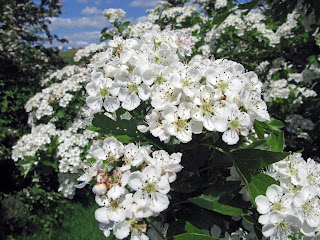Week 8 of the 2016 transect-walking season at Castle Hill LNR
 |
| Thrift in bloom at Castle Hill LNR |
Moths were seen in good numbers this week, but these were mostly 'micro-moth' species which require a close search. It is well worth taking the time to search for these around the woody areas of the reserve though because you may be rewarded with the sight of a spectacular Sulphur Tubic (Esperia sulphurella) or Common Tubic (Alabonia geoffrella). Nine of the species seen belong to the large family of moths known as Tortrixes. Tortrix species fly at dusk and on calm, overcast days, as well as at night. The family has about 440 members, so it is one of the larger families. Forty four Tortrix species have now been recorded at Castle Hill - only another 90% are now left to find!
One of the new additions to the site list is the Cocksfoot Moth (Glyphipterix simpliciella). This is one of the smallest but most common of the British species. David and I saw an estimated ten thousand of these moths in a few hours between Lewes Racecourse and Mount Harry in Lewes some years ago. Where they are present, they can be found on the heads of yellow flowers such as buttercups, with a dozen or more nestled in a single flower-head. They are easy to find, abundant, but curiously absent from some areas where one might expect to find them. My personal opinion is that they have a preference for low-nutrient, poor-quality soils (such as chalk grassland), where the diversity of flora is greater. It is therefore a relief that this previously absent moth has finally turned up at Castle Hill after many years fruitless searching.
Other insect orders were seen in good numbers during the survey. Most of these are not counted so that attention can be focused on the butterflies and moths, but some regular species are included in my count such as dragonflies and damselflies, Heteroptera 'true' bugs (e.g. shield-bugs), some beetle families, crickets and grasshoppers. Bees, wasps and hoverflies are left for other, more knowledgeable, recorders to work on!
A dragonfly and plenty of damselflies were seen, mostly around the damp, scrubby areas on the north-facing slope - including an example of the Variable Damselfly (Coenagrion pulchellum), which it is believed is another first for Castle Hill LNR. This is a species which has a scattered distribution over England and Wales, but it is much more widespread in Ireland. It is an excellent addition to the site list and I hope that more are seen. Careful attention needs to be given during identification in order to separate it from Azure and Common Blue Damselflies.
 |
| Variable Damselfly (Coenagrion pulchellum) |
Week 8 species list
Butterflies (10 species)
Large White (Pieris brassicae) 2
Small White (Pieris rapae) 6
Green-veined White (Pieris napi) 1
Wall (Lasiommata megera)
2
Speckled Wood (Pararge aegeria) 6
Small Heath (Coenonympha pamphilus)
2
Red Admiral (Vanessa atalanta) 1
Green Hairstreak (Callophrys rubi) 9
Common Blue (Polyommatus icarus)
5
Holly Blue (Celastrina argiolus)
3
Moths (22 species)
Mullein (Shargacucullia verbasci)
3 larvae
Silver Y (Autographa gamma) 1
Mother Shipton (Callistege mi) 1
Small Purple and Gold (Pyrausta aurata) 1
Straw-barred Pearl (Pyrausta despicata) 1
Lackey (Malacosoma neustria) 2 larvae
Mottled Pug (Eupithecia exiguata)
1*
Fruitlet Mining Tortrix (Pammene rhediella) 2*
Grey Gorse Piercer (Cydia ulicetana) 22
Red-barred Tortrix (Ditula angustiorana) 1*
Yellow-spot Twist (Pseudargyrotoza conwagana)
1
Common Marble (Celypha lacunana) 3
Marbled Orchard Tortrix (Hedya nubiferana) 1
Knapweed Bell (Epiblema cirsiana)
2*
Silver Carrot Conch (Aethes williana) 1
Light Brown Apple Moth (Epiphyas postvittana) 1
Sulphur Tubic (Esperia sulphurella)
3
Common Tubic (Alabonia geoffrella)
3
Common Nettle-tap (Anthophila fabriciana)
7
Apple Leaf Skeletoniser (Choreutis pariana) 1*
Cocksfoot Moth (Glyphipterix simpliciella)
1*
Gorse Case-bearer (Coleophora albicosta)
1*
*new species - not previously recorded
at Castle Hill LNR
Damselfies and Dragonflies (6 species)
Large Red Damselfly (Pyrrhosoma nymphula) 1
Blue-tailed Damselfly (Ischnura elegans) 1
Common Blue Damselfly (Enallagma cyathigerum) 1
Variable Damselfly (Coenagrion pulchellum) 1
Azure Damselfly (Coenagrion puella)
11
Hairy Dragonfly (Brachytron pratense) 1
True bugs (4 species)
One of the Mirid bugs: Stenodema laevigata 6
Gorse Bug (Piezodorus lituratus) 2
Dock Bug (Coreus marginatus)
54
One of the Rhopalid bugs: Corizus hyoscyamii 1
Beetles
Thistle Tortoise Beetle (Cassida rubiginosa) 14 – mostly seen
on broad-leaved low plants (e.g. burdock)
Common Cardinal Beetle (Pyrochroa serraticornis) 4
Crickets and grasshoppers
Speckled Bush Cricket (Leptophyes punctatissima) 2 nymphs
Flora
Ragged-Robin (Lychnis flos-cuculi) 2 plants in the ‘Friends Glade’ near the
lower car park
 |
| Lackey (Malacosoma neustria) |
 |
| Marbled Orchard Tortrix (Hedya nubiferana) |
 |
| Green Hairstreak (Callophrys rubi) |

Marbled Orchard Tortrix (Hedya nubiferana) and the stunning Rhopalid bug Corizus hyoscyamii
More bugs: Gorse Bug (Piezodorus lituratus) and Dock Bug (Coreus marginatus)
 |
| Common or Red-Headed Cardinal Beetle (Pyrochroa serraticornis) |
 |
| Cliff-top erosion along western part of reserve |
 |
| Hawthorn or May blossom (Crataegus monogyna) |
 |
| Flowering umbellifers along northern track |




No comments:
Post a Comment